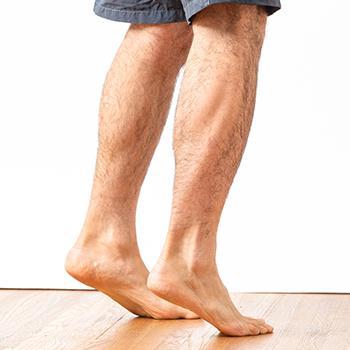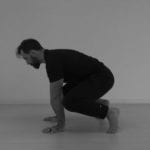 Injuries suck, and can be an unfortunate yet expected part of building a fitness habit.
Injuries suck, and can be an unfortunate yet expected part of building a fitness habit.
We’ve talked before about injuries and how you can deal with them if they arrive as well as how to know if you are indeed injured.
What we haven’t really covered before, though, is how to successfully resume training after you’ve recovered from an injury.
How do you start back up with training once you’re healed up and cleared by your doctor?
Is there a way to ease back into training that ensures you quickly and safely return to where you were before?
In this episode of the GMB Show, Andy and Ryan reveal their smart strategies for safely and effectively resuming training after recovering from an injury.
You’ll hear:
- 13:48 – How to deal with injuries when they do happen.
- 15:50 – Here’s how you can tell if you’re ready to resume training.
- 17:17 – How to handle your first day back.
- 21:47 – The order of fitness attributes you may “lose” if you take a bunch of time off.
- 26:35 – Ryan’s “scientific” formula for how much time to give yourself to get back into your program.
An important thing to remember when you’re coming back from an injury is that you’re not going to be able to just start right where you left off, so always approach your first session back as a trial run.
The key to resuming training is to give yourself time to regress in order to progress. Do that, and you’ll go a long way to setting yourself up for injury-free success.
Returning to Training After A Break
Andy: All right. Breaker, breaker one-niner, get your ears on for the GMB Fitness Skills Show. Over the next 30 minutes plus or minus, we’re going to be hitting you with all kinds of great information for your training, for your life and how to do it in a way that’s actually fun and enjoyable.
So my name is Andy. Here with my Ryan Hurst, the man, the myth, the legend, the aging rock icon.
Ryan: I love it.
Andy: A little – the Hank Rollins [0:00:45] [Phonetic] there.
Ryan: A little Henry for you. What’s up everybody? What’s up? What’s up? We got a good show today. Yeah, a good one.
Andy: Yeah. Are you surviving the winter OK so far?
Ryan: Yeah, it’s starting to warm up so things are OK. I actually shaved the hair. I shaved my beard. Yeah.
Andy: I have not shaved in a couple of days. So this is what we’re reduced to now. We have nothing better to talk about than our grooming habits.
Ryan: That’s all there is. That’s all there is.
Andy: Yeah, which actually isn’t true. We’re going to talk about some actually – I think this is going to be a really useful episode for people because today we’re going to be talking about something that we haven’t actually covered at all ever on the show.
We’ve talked a lot about what to do if you get injured, what to do if you get sick, what to do if things get busy and have to take some time off. But the one thing we haven’t really discussed is how to get back on track after that.
It’s how to start backing your training and without losing any more time than necessary. So we’re going to get to that in a few minutes. But first, let’s answer some questions.
Ryan: All right.
[Music]Andy: All right. So we’ve made videos about these things and covered them before but it’s always something that comes up again and so I just want to give maybe on one place here some quick advice, simply about equipment.
So let’s talk about rings and parallettes both, what height, what width, how can we tell that they’re set up properly because especially with rings if they’re not set up well, the exercises are going to be really hard and I mean you could injure yourself. But what’s – give us for each of those. What are your recommendations?
Ryan: Yeah, it’s very simple. Just keep it very simple and just keep the rings and the parallettes just a bit wider than shoulder width. A good way to check is if you take your arm and go from elbow to middle finger.
For some people, that’s actually going to be – I don’t want to say too wide but you might feel that you want to bring them in a little bit more. If that’s the case, then just bend your fingers and go from that knuckle there to set the width of the P bars.
Remember, when you’re setting your P bars, it’s going to sound funny but when you set your P bars, make sure you set the P bars in the middle instead of just doing one end because I’ve seen people like set just the end and their P bars end up making a triangular shape.
The rings are the same way. If you’re hanging your rings from a bar, from a branch, from whatever, place them a little wider than shoulder width. You should be able to feel that because if you feel cramped when doing the rings, it means they’re just too narrow. Likewise, if you feel like constantly having to pull them in unnaturally, then they’re too wide.
So that’s just a basic setting for the width. As far as height, with the parallettes, I would say start off with about a foot in the beginning if you want to just buy one set of parallettes. So if you have the option of having different sets, then maybe you could go a little higher and then just a little lower.
I use a very low set of parallettes but the thing is, is I’ve been doing this for a little while. So as you get closer to the floor, it’s obviously going to be more difficult. So adjust those accordingly.
As far as if you’re using plastic, if you’re using wood or if you’re using pipes or other kinds of metals, you just need to find a pair that you feel that you can use for the long run. So you might want to set them very low to the ground but you also have to think about some of the other exercises that you will be performing down the line and whether or not you will have the proper clearance to be able to perform those movements.
So it’s a preference thing but also a level thing. Just to say it one more time, remember as they get closer to the ground, they’re going to be more difficult because you won’t have as much clearance on the parallettes.
[Music]Andy: Let’s also talk about height on the rings because with rings, we work actually at three different heights depending on the exercises we’re doing. In our programs, we have three different heights that we use. So how can you tell what is the right height for you for each of those three?
Ryan: Sure. So if we look at a low height, so low would be where we’re working on something like the push-up, the hollow body push-up or even as you get into the more advanced stages and where you’re working on handstands. I suggest taking the rings low to the ground and by low, I’m talking like six, maybe eight inches off of the ground, just enough so that you have that clearance below. So that in case you need to go down, you’re not going to skim your knuckles or anything on the ground.
So that would be kind of the low level. The mid level, if let’s say you’re just beginning and you want to work on the top position or there’s some other movements where you just want to get comfortable with being above the rings and pushing down into them, then I would say waist level.
So the reason for this is because you’re still going to be able to have your feet on the ground and use them as training wheels. So if you’re working on the top position, you can start to work on the stability by using your toes and your feet to help you.
Then you can gradually raise them up slightly. Now the highest position at the top, the top, top, top position, if you can, make it as high as you can. An example here in the gym when I set things up for anyone who’s using the rings, is that there’s just a slight clearance. So if they jump off of the ground, it’s again upwards of maybe six to eight inches of foot clearance.
This is of course quite challenging and it’s all going to depend on your ceiling. So if you’re using a pull-up bar or something to put your rings on, obviously you’re not going to be able to have them that high.
Something else to always remember is that the longer the strap, the more – or the less stability you’re going to have with the rings. So when you look at gymnasts in the Olympics and you see that they’re on a ring stand and a ring stand, we’re talking that thing is way up in the air and it has got very, very long cable attached in the rings.
Extremely – the stability of those is just horrible. Now that should let you know just how good they are. But let’s say you go to the playground and there is a pull-up bar that is relatively short, that you can grab a hold of. If you hold your rings on there, they’re going to be quite stable to be honest because the link of the strap is actually short.
So the shorter the strap, the more stability you will have. If you want to challenge yourself, find a very high ceiling or somewhere where you can hang your rings with a very long link to strap and it’s going to make the movements more difficult.
[Music]Andy: Because a lot of people also ask us too. You mentioned using like a pull-up bar. People ask us all the time. Can I use rings on a doorway pull-up bar? And the answer is yes. It’s not ideal but it’s totally possible.
Now, you will have to make some adjustments and some compromises if that’s the set-up you have. You’re not going to be able to do full muscle-ups with full range of motion from hanging all the way below and hanging up over because you would put your head through the roof.
But it’s possible to begin to lower the rings and sit down on the floor even and practice muscle-ups in an L-sit position or something like that.
So don’t let your environmental situations prevent you from being able to practice things you want to practice but know what’s ideal and then make adjustments based on the environmental situation that you have to work with.
Ryan: Exactly. That’s a very good point. I mean just because you don’t have the clearance to be able to perform a particular move that you can’t get creative and you brought up a good point of lowering the rings to the point where you’re actually sitting on the ground.
This is something that I actually worked on just to improve my muscle-ups. Now it’s lowering the rings so I had to sit on the ground with my legs out in front of me and work on pulling from there.
You don’t get a lot of English going on in the body when you’re sitting on the ground. This is actually a very good way to help you strengthen your muscle-ups and your chin-ups.
Andy: Yeah, yeah, definitely. So very good, very good. So definitely those are recommendations, basics, and it’s always going to depend on you a little bit and where your level is at. So don’t take any of these as written in stone. It’s not scripture. Figure out what’s going to work for your situation.
Ryan: Yes.
Andy: Anything else to say about equipment, setup, things like that?
Ryan: Just be safe and you can see some pretty funny videos of people using a chin-up bar between a doorframe and the thing comes crashing down. If you’re performing a pull-up, yeah, that might be funny and it’s going to be OK. But if you’re inverted, if you’re upside down performing something on the rings and that bar comes crashing down, there’s a possibility that you could break your neck and we don’t want that.
So whatever you do use, a tree, a limb, a tree branch, whatever, it doesn’t matter. Make sure that it is properly attached and stable before you get upside down.
Andy: Yeah.
[Music]Andy: Always make sure your equipment is solid. That’s one reason why we recommend the rings we recommend. Right now, the best ones we’ve seen in terms of being comfortable and solid and made by a reputable manufacturer, Rogue, the wooden rings. We like this a lot. I actually had somebody send an email a few days ago. Why do you recommend those?
Well, hey man, if you don’t like our recommendation, use something else. But we recommend them because in our experience, in the experience we do have, those are the best ones that we’ve tried.
Now we’re open to trying more things. A couple of manufacturers have actually asked to send us some rings that we’re waiting to test right now. So that could change.
But we like those because it has those qualities and we feel that they’re safe and usable. Same things with P bars. We recommend the ones that our client and friend Dusty makes.
Some people say, “Well, what if they get loose after using them?” Well, it’s very easy. Dusty makes them. Quite easily take the Allen keys he sends you and I think after like a year of use, you will have to tighten them once and then they will be solid for the rest of your life.
Ryan: Yeah, and along those lines, I mean I prefer to use the wooden rings and I prefer to use the wooden parallettes. Now that doesn’t mean that if you use something else, that it’s wrong.
Find something that you really enjoy using. I know my good friend Mike Fitch, he doesn’t use the wooden parallettes. He prefers a different style of parallettes. That’s perfectly fine. I mean just find something that you like to use. Make sure that it’s quality, a quality piece of equipment and be safe. That’s it.
Andy: Yeah. Same thing with – if budget is a big concern for you, you can go to Amazon and I think MuscleDriver makes a pair of plastic rings and it’s very reasonable. Ultimate Body Press makes a pair of plastic rings. It’s very reasonable. You can make parallettes out of PVC. Please actually use the pipe cement though because PVC being plastic, it will slip. It will slip if you don’t use the cement and we’ve heard stories of people having pretty bad accidents on them.
Ryan: Yeah.
Andy: So using cheaper, less expensive things is OK. But make sure that you test it when you’re using it.
[Music]Andy: So with that said, let’s say that you did forget to use the pipe cement. You slipped on your P bars and twisted your wrist or something and had to take some time off of P1 for example and you healed up. You’re ready to go.
How do you start back? We will get specific maybe in a couple of minutes but maybe Ryan just talk about starting back. I mean you’ve been injured. You’ve been sick in various phases in your training so to speak. So maybe what do you really think is the most important consideration?
Ryan: Well, first and foremost, if you did injure yourself, the first thing you need to do is get the doctor’s OK to make sure that it’s OK to start training again. We can’t stress that enough. That’s very important.
But once you get the OK, and you’re ready to get back into it, the most important thing is to remember that you’re not going to be able to start where you left off and so if you go back into your workout and think that you’re going to just jump right back into it and be able to perform at the same level, well, you’re sorely mistaken and you’re probably going to end up injuring yourself again.
So the thing is to really take a few steps back. It can be humbling but really just put your ego to the side and understand that you’ve got to start over again. It doesn’t mean from the very beginning.
Andy: No.
Ryan: Now, the strength will come back very quickly. This is not something where you’re going to lose all of your gains if you happen to take a week off or something like that and if you’re talking about – let’s just look at the injury first, then we will talk about sickness in a moment. But if you’re looking at an injury, depending on the injury, when you go back and start training, first and foremost is stepping back but also taking stock of that injury.
What is the feeling you’re getting from it? Does it feel – I don’t want to say strong because obviously if it’s an injury, it is going to be weak. But does it feel safe? Are you performing? Are you doing something where you can build from there?
Andy: Do you have the requisite level of physical integrity? By integrity, that means if you injured a bone, is the bone solid enough to continue? It’s not going to be as strong as before but if you injured a muscle or a ligament or something, can you – is it strong enough? Like you said, it will be weaker. But does it have the structural integrity to pick up?
Ryan: To put load on it and use it.
[Music]Ryan: What you’re also going to find is when you’re coming back from an injury, is that you’re going to end up favoring that injury maybe without even knowing it. So this is going to change your form in the movement. So that’s another thing you need to look at and that is why we go back to maybe even the very first basic movement and we do a systems analysis of what’s going on.
Where’s your form? Are you favoring that particular injury? Are you able to place a load on that injury safely? And then the next day you need to check and see how you feel after performing that first day back.
So there are a lot of little things to look out here and that’s why I suggest not just jumping back into it. You might feel great. You might go into work and go, “Oh yeah, I’m feeling awesome. Yeah.”
The next day you wake up and let’s say you injured your wrist before, the next day, you wake up and if it’s hurting so badly, you’re like, “Oh man, I think I did something to it,” well you did way too much that first day back.
Andy: Yeah, and that’s a really important point that I think a lot of people don’t even consider is that your first day back to training, your first return to training, your first session should always be looked at as a trial. You should view it as a trial. This is not the beginning of your new program. This is not – OK, I can start and just go now. No, it’s not like that. It’s a test. It’s always a test and as such you should do the minimum amount. Do the minimal amount. Warm up properly. Do a minimal amount. Do not push yourself towards your limits and then see how you feel. You can’t tell how you feel right away.
You may feel great but still consider it a test because you might not know until the next day like you said. So always, always, always let your first session back be a test.
This is true of any kind of training we’re talking about. You’re not going to miss anything. If you’ve taken three days off or a week off or a month off, you’re not going to lose out on anything or fall behind by letting your first day be a trial.
So go on and take that chance to know for sure and see how you do feel and see how you feel the next day and then you will have a lot better idea of what your level truly is when you’re trying to get back into things.
[Music]Ryan: If you are coming back from an injury, and let’s say it was pretty bad. Let’s say you had a very nasty sprain or heaven forbid, you tore something, a ligament or something like that.
Make sure that your workouts don’t interfere with your rehabilitation of that injury. So if your PT or depending on what country you’re in, your physio says, “OK, I just want you working on this rehab for this particular joint,” or whatever, just do that. No more. So again, listen to your doctor and then when you go back to it, make those – I don’t want to say adjustments but find out what’s going on so that you can start to work on building it up later. I mean later after you check everything out.
Now looking at sickness, if you’ve been sick, let’s say – an example of me is I had a very bad sinus infection. It wasn’t that I was sick. It was that I was so congested that it hurt to be upside down.
Now, obviously, I didn’t go upside down. That was very simple. There’s nothing to get around it. That’s one of those things where I just find it funny where people are like I’m just going to push through the pain. I’m like … [0:20:00]
[End of transcript]Be sure to catch the next episode by subscribing to the GMB Show:


